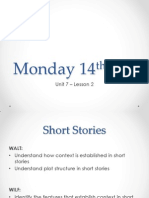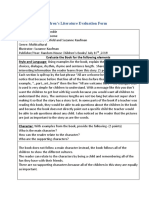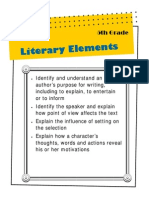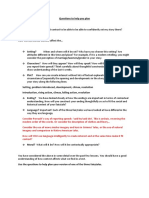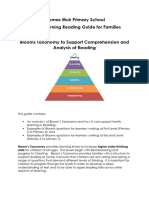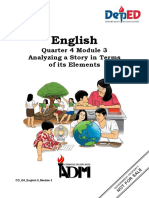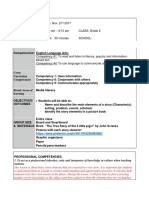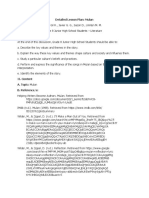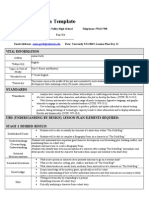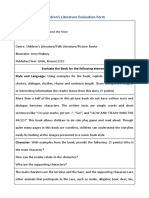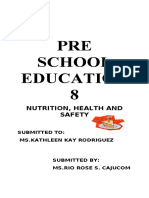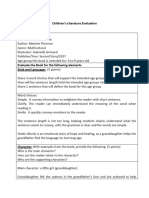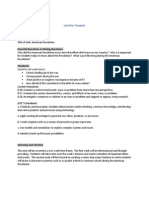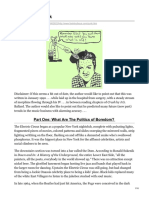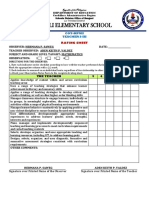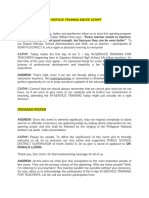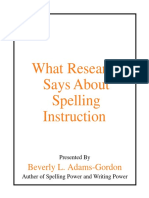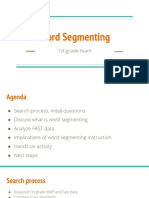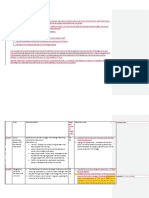Blooms Taxonomy
Blooms Taxonomy
Uploaded by
Steve RadermanCopyright:
Available Formats
Blooms Taxonomy
Blooms Taxonomy
Uploaded by
Steve RadermanCopyright
Available Formats
Share this document
Did you find this document useful?
Is this content inappropriate?
Copyright:
Available Formats
Blooms Taxonomy
Blooms Taxonomy
Uploaded by
Steve RadermanCopyright:
Available Formats
BLOOMS TAXONOMY & Story Elements: An easy guide to
understanding the code on each yellow card to maximize comprehension & metacognition:
Blooms Taxonomy (Benjamin Blooms Taxonomy of Educational Objective, 1956) is one classification system that
demonstrates the many types of questions that can be taught in developing comprehension. The categories can
overlap. This offers a guide for teachers, parents and students in generating questions that reflect different levels of
thinking and comprehension. Questions in generic form taken from the levels can be learned and internalized by
readers so that they can think about and focus on these while reading, heightening their comprehension process. Such
questioning can be done before students even learn to read, after reading to them. Such questioning can be done about
TV shows, movies, plays and day- to- day life experiences. Specific questions from the different categories will
ensure a deep understanding of what is read. Students can learn how to generate questions reflecting these categories.
Story Elements include the Settings (places, times in the story) the Plot (what happens in the story); the Characters
(the people, animals, beings in the story); and the Themes (main ideas, morals, universal truths, universal
relationships; lessons learned)
To demonstrate the categories, Cinderella is used below. The questions are only examples of each
category and by no means exhaustive. Next to each question you will see a bold S for Setting, P for
Plot, C for Character or T for Theme. You can see how questions can reflect overlapping elements. Two
yellow cards show how the code is used for meta cognition and teaching purposes.
KNOWLEDGE LEVEL:
These are questions recalling facts and details about characters, setting or plot and can include what, where, who,
when, how and where questions.
Yellow cards in the game are coded on the left bottom: Story Element-Blooms
level or levels
What part of the story did you
like best and why?
How many stepsisters did Cinderella have? C
When did Cinderella leave the ball?P
What was used to make Cinderellas carriage? P/S
Where did Cinderella meet the prince? S
Who helped Cinderella get to the ball? C
*What part of this week did
you like best and why?
P-ANA
COMPREHENSION LEVEL:
Plot
analysis
These questions check for understanding memory (sequence) or interpretative skills and include the why questions
and retelling parts or the whole plot.
Why was Cinderella sad? C/P
Retell three main parts of the story in the order that they happened. P Why were the stepsisters so mean to
Cinderella? C
Return Home
APPLICATION LEVEL:
These questions apply the text to the readers world and other texts.
Can you think of a time when you wanted to go somewhere very badly and you couldnt, like Cinderella
wanting to go to the ball? C/P/T
Do you have someone in your life like Cinderellas Fairy Godmother? T/C
Can you think of a time this person helped you? P/C
How is Cinderella like another book or movie you know? P/C/T/S
ANAYLYSIS LEVEL:
These questions break down information by categorizing or identifying parts.
What part of the story made you feel excited? Happy? Sad? P
What was your favorite part of the story? P
Where in the story would you like to visit? S
What place in the story did you not like? Why? S
What could be real or make-believe? (fact or fantasy) C/P/S/T
SYNTHESIS LEVEL:
Plot, Character, Theme, Setting
What new idea or thought
did you think of because
of this story?
*What is something new you could
try or learn more about because of
this story?
P/C/T/S-ANA/SYN
Analysis, Synthesis
Here you are taking what is given and creating something new. These are questions that use the information in the
story in a new, original way by expanding on what was given. Such examples of these would be taking a characters
point of view or creating a new ending for the story.
What would it be like to have Cinderella for a friend? C/P
How would you change the ending of Cinderella? P/S
Rewrite the story with a nice stepmother. C
Become a character in the story and tell the story from your point of view. C
EVALUATION LEVEL:
These questions help us decide on the value of our information. They can be questions about the theme or lessons
learned from the story. They are questions about making judgments about the plot, characters, theme or setting.
Do you think the story had a happy ending? P
Why or why not? Who is a kind character in the story? C
What is a lesson learned (or theme) in the story of Cinderella? T
Did you like this story? Why or why not? P/C/S/T
Return Home
You might also like
- A Handbook For Waldorf Class TeacherDocument101 pagesA Handbook For Waldorf Class TeacherCristina Ancuta94% (17)
- The JourneyDocument7 pagesThe Journeyra ayNo ratings yet
- Lesson Plan Cot Grade 9 Health ThirdDocument7 pagesLesson Plan Cot Grade 9 Health ThirdFLORENCE VILLANUEVA100% (11)
- Final ReflectionDocument4 pagesFinal Reflectionapi-262820803No ratings yet
- Hope 1Document22 pagesHope 1Carl90% (31)
- Monday 14thDocument25 pagesMonday 14thapi-233668463No ratings yet
- The Amazing Lifecycle of A ButterflyDocument3 pagesThe Amazing Lifecycle of A Butterflyapi-516686222No ratings yet
- Coaching For Comprehension:: Questions and Prompts For TeachersDocument1 pageCoaching For Comprehension:: Questions and Prompts For TeacherstracycollinsNo ratings yet
- Children's Literature Evaluation FormDocument4 pagesChildren's Literature Evaluation Formapi-548865153No ratings yet
- A 76 D 223 Bedebb 3 CDocument4 pagesA 76 D 223 Bedebb 3 Capi-534711007No ratings yet
- Five Elements of A StoryDocument5 pagesFive Elements of A StoryLisa B ArnoldNo ratings yet
- Cambridge Story Competition Lesson Plan333444Document5 pagesCambridge Story Competition Lesson Plan333444Eduardo Martin SanchezNo ratings yet
- Literary Elements For Grade 5Document45 pagesLiterary Elements For Grade 5Bechir Saoudi100% (4)
- Lesson Plan 2Document9 pagesLesson Plan 2api-283964589No ratings yet
- Questions To Help You Plan Initial IdeasDocument1 pageQuestions To Help You Plan Initial Ideas노휘소No ratings yet
- FINAL English 10 Q1 Module 6.pdf - 20240405 - 021028 - 0000Document26 pagesFINAL English 10 Q1 Module 6.pdf - 20240405 - 021028 - 0000Jarred De UngriaNo ratings yet
- +yr 9 Short Story Workbook Part 1 PDFDocument12 pages+yr 9 Short Story Workbook Part 1 PDFapi-263480603100% (1)
- Blooms Taxonomy A Guide To Support Family LearningDocument6 pagesBlooms Taxonomy A Guide To Support Family Learningtechray2020No ratings yet
- Eng9 Q4 Mod3Document22 pagesEng9 Q4 Mod3reyanna mae agunodNo ratings yet
- Children's Literature Evaluation FormDocument5 pagesChildren's Literature Evaluation Formapi-534711007No ratings yet
- Lesson On Story ElementsDocument5 pagesLesson On Story Elementsapi-385152326100% (1)
- Booktalk RubricDocument1 pageBooktalk RubricBJ NearyNo ratings yet
- BiographyDocument6 pagesBiographyapi-594216169No ratings yet
- Picture BookDocument6 pagesPicture Bookapi-594216169No ratings yet
- Story Telling in EnglishDocument12 pagesStory Telling in Englishtrain_xii15100% (1)
- Mulan Fsts Lesson PlanDocument5 pagesMulan Fsts Lesson PlanDeryl SazonNo ratings yet
- Writing A Literary AnalysisDocument3 pagesWriting A Literary Analysisandreas.tanoNo ratings yet
- Final SHS 12-Creative Non-Fiction-Q1-Module 1-Themes and TechniquesDocument20 pagesFinal SHS 12-Creative Non-Fiction-Q1-Module 1-Themes and TechniquesSil Marie Maramba80% (5)
- Cue Cards For IELTSDocument28 pagesCue Cards For IELTSFreddy InostrozaNo ratings yet
- Lesson Plan 1 For ObservationDocument2 pagesLesson Plan 1 For ObservationRoopa NatarajNo ratings yet
- Task 1Document12 pagesTask 1Mc Cruzt KristoferNo ratings yet
- Ubd Lesson Plan Day 11Document3 pagesUbd Lesson Plan Day 11api-283124333No ratings yet
- Shortlesson Plan Template For Gus Takes The TrainDocument6 pagesShortlesson Plan Template For Gus Takes The Trainapi-643841683No ratings yet
- CesarreflectionDocument6 pagesCesarreflectionapi-321926938No ratings yet
- Children's Literature Evaluation Form: Jerry PinkneyDocument4 pagesChildren's Literature Evaluation Form: Jerry Pinkneyapi-534711007No ratings yet
- Understanding and Writing Pourquoi StoriesDocument5 pagesUnderstanding and Writing Pourquoi StoriesDiannaGregoryNarotskiNo ratings yet
- Children's Literature Evaluation Form: Knopf/1988Document4 pagesChildren's Literature Evaluation Form: Knopf/1988api-534711007No ratings yet
- Dont Let The Pigeon Drive The BusDocument3 pagesDont Let The Pigeon Drive The Busapi-507723815No ratings yet
- Language Arts Lesson PlansDocument6 pagesLanguage Arts Lesson Plansapi-312579198No ratings yet
- Literacy Lesson Plan Term 3 Grade Level: 4th and 6th Grade Number of Students 6-8 Time: 45 MinutesDocument3 pagesLiteracy Lesson Plan Term 3 Grade Level: 4th and 6th Grade Number of Students 6-8 Time: 45 Minutesapi-302264322No ratings yet
- Lesson Plan Format: Class: Date: Time: Start: Finish: Key Learning Area: Lesson TopicDocument9 pagesLesson Plan Format: Class: Date: Time: Start: Finish: Key Learning Area: Lesson Topicapi-297648038No ratings yet
- Paper Bag Book Report and Rubric Language Arts GradesDocument12 pagesPaper Bag Book Report and Rubric Language Arts Gradesfrancoisedonzeau1310No ratings yet
- LiteracycurriculummapDocument40 pagesLiteracycurriculummapapi-312336330No ratings yet
- Creativewriting12 q1 Mod4of5 TheElementsofFiction v2Document27 pagesCreativewriting12 q1 Mod4of5 TheElementsofFiction v2doane nadongNo ratings yet
- Unit FoundationDocument2 pagesUnit Foundationapi-283964589No ratings yet
- Historical FictionDocument6 pagesHistorical Fictionapi-594216169No ratings yet
- Contemporary Realistic FictionDocument7 pagesContemporary Realistic Fictionapi-594216169No ratings yet
- Multicultural/Diversity Lesson 1: Cinderella StoriesDocument5 pagesMulticultural/Diversity Lesson 1: Cinderella StoriesIan Noya100% (1)
- Children's Literature Evaluation FormDocument3 pagesChildren's Literature Evaluation Formapi-507723815No ratings yet
- BloomsDocument8 pagesBloomsCarrie Cunniff MalnorNo ratings yet
- Conversation and Speaking Activities: Role PlayDocument6 pagesConversation and Speaking Activities: Role PlayViolet Gurion CaparasNo ratings yet
- Guided Reading Lesson Plan - Observation 5Document9 pagesGuided Reading Lesson Plan - Observation 5api-298891012No ratings yet
- Cot Elements of Story 2022Document8 pagesCot Elements of Story 2022John Matthew CerenoNo ratings yet
- PRE School Education 8: Nutrition, Health and SafetyDocument11 pagesPRE School Education 8: Nutrition, Health and SafetyKathleen Kay Rodriguez CruzNo ratings yet
- Storytelling in Words and Pictures: How To Write Graphic Novels and ComicsDocument24 pagesStorytelling in Words and Pictures: How To Write Graphic Novels and ComicsJanet Stone100% (4)
- Smile: Novel Resource Guide ForDocument26 pagesSmile: Novel Resource Guide ForAndrea Hernandez-Vila14% (7)
- English 4 Matatag Pt2Document9 pagesEnglish 4 Matatag Pt2Pathie AlagbanNo ratings yet
- MulticultureDocument6 pagesMulticultureapi-594216169No ratings yet
- Children Literature Evaluation Form-Historical FictionDocument3 pagesChildren Literature Evaluation Form-Historical Fictionapi-519326403No ratings yet
- Literature Evaluation FloktaleDocument3 pagesLiterature Evaluation Floktaleapi-507723815No ratings yet
- MR Youngs American Revolution UnitDocument3 pagesMR Youngs American Revolution Unitapi-248927617No ratings yet
- On Stage at Any Age: Drama Scripts for Fun and PerformanceFrom EverandOn Stage at Any Age: Drama Scripts for Fun and PerformanceNo ratings yet
- Pitch Axis TheoryDocument2 pagesPitch Axis TheorySteve Raderman100% (1)
- Punk RockDocument59 pagesPunk RockSteve RadermanNo ratings yet
- Women in Punk RockDocument29 pagesWomen in Punk RockSteve RadermanNo ratings yet
- A History of PunkDocument16 pagesA History of PunkSteve RadermanNo ratings yet
- The Jimi Hendrix Experience Baton Rouge Concert PosterDocument1 pageThe Jimi Hendrix Experience Baton Rouge Concert PosterSteve Raderman100% (1)
- The Munsters TabDocument3 pagesThe Munsters TabSteve RadermanNo ratings yet
- Major Pentatonic ScaleDocument1 pageMajor Pentatonic ScaleSteve RadermanNo ratings yet
- Diagnostic PretestDocument2 pagesDiagnostic Pretestapi-285606546No ratings yet
- Technology Lesson PlanDocument10 pagesTechnology Lesson Planapi-290914911No ratings yet
- The 12 Principles of High Quality Assessment of Learning For TeachersDocument2 pagesThe 12 Principles of High Quality Assessment of Learning For TeachersClydylyn Pastor100% (2)
- Singing Is Seriously SimpleDocument17 pagesSinging Is Seriously SimpleKevin Bryan Manzano DyNo ratings yet
- Cot Rpms Rating SheetDocument1 pageCot Rpms Rating SheetAden Keith Paus ValdezNo ratings yet
- In-service Training Emcee ScriptDocument3 pagesIn-service Training Emcee ScriptRam KuizonNo ratings yet
- Writing ModuleDocument39 pagesWriting ModuleKureen FreddieNo ratings yet
- What Research Says About Spelling Instruction: Beverly L. Adams-GordonDocument21 pagesWhat Research Says About Spelling Instruction: Beverly L. Adams-GordonMelcah Acosta Mercado100% (1)
- Welder 6 MONTHS 800hrsDocument22 pagesWelder 6 MONTHS 800hrsnicekhanNo ratings yet
- Serbian Education System9Document25 pagesSerbian Education System9leptonNo ratings yet
- Homophone Reading Lesson PDFDocument3 pagesHomophone Reading Lesson PDFapi-239228406No ratings yet
- Bahay Pag Asa PaperDocument14 pagesBahay Pag Asa PaperMigz BrosasNo ratings yet
- Newsletter 233Document7 pagesNewsletter 233St Bede's Catholic CollegeNo ratings yet
- Grade 4 Pe Lesson 4 Gymnastic StationsDocument16 pagesGrade 4 Pe Lesson 4 Gymnastic Stationsapi-300873678100% (1)
- Word SegmentingDocument14 pagesWord Segmentingapi-443207039No ratings yet
- English Program FinalDocument34 pagesEnglish Program Finalapi-204772730No ratings yet
- The Poet, Poem and The People - The Trio by Subramanian ADocument6 pagesThe Poet, Poem and The People - The Trio by Subramanian ASubramanian ANo ratings yet
- Cheat SheetDocument5 pagesCheat SheetKanwal IshfaqNo ratings yet
- Teacher Classroom Observation ChecklistDocument4 pagesTeacher Classroom Observation ChecklistAphze Bautista VlogNo ratings yet
- Mijwan Welfare SocietyDocument16 pagesMijwan Welfare SocietynidhisanjeetNo ratings yet
- Prof Ed 6 - Scope and SequenceDocument2 pagesProf Ed 6 - Scope and Sequencenhikie del socorroNo ratings yet
- Auxiliary VerbsDocument28 pagesAuxiliary VerbsMd Tabish RazaNo ratings yet
- Directory FinalDocument134 pagesDirectory FinalDevarshi Mandal100% (1)
- IITT Classroom 2012Document197 pagesIITT Classroom 2012VIJAY KUMAR HEERNo ratings yet
- Eoc Writing PromptsDocument6 pagesEoc Writing Promptsapi-233600302No ratings yet
- Philosophy StatementDocument3 pagesPhilosophy Statementapi-314184805No ratings yet





